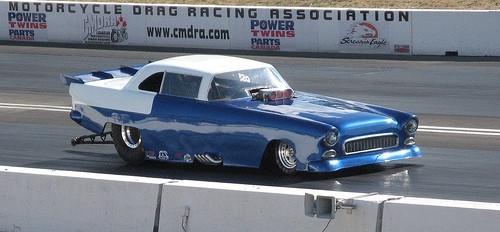
Vehicle owners have been on a quest for speed and performance ever since the first driver stepped behind the wheel, and with today's plethora of aftermarket options, making your car go faster has never been easier. Performance comes at a cost. Higher horsepower and harder driving will put more stress on not only the vehicle's engine, but also the brakes and suspension.
Many seasoned racers often compare an engine to an air pump, in that the more air you can draw into it the more power you will get out. High performance air filters such as those made by K&N work by lessening the restrictions on air flowing into the engine. A cold air intake draws cold air from outside the engine bay. Cold air is more dense than hot air, therefore more air can be packed into each cylinder. Lightweight aluminum intakes can be a vast improvement over the stock pieces on older vehicles. They tend to flow better and are lighter weight versus cast iron counterparts, which means the engine needs to do less work to propel the vehicle.
The exhaust system channels exhaust gases away from the engine and out of the vehicle. Restrictions in the exhaust system can rob power that could otherwise be used to make the car go faster. Headers can improve flow and are much lighter than the stock cast iron exhaust manifolds. Most performance exhaust systems rely on larger diameter pipes to reduce back pressure. Many use a dual muffler and exhaust tract setup, which increase power. If you have a later model vehicle, you may want to upgrade to a high performance catalytic converter.
The ignition system consists of the distributor, spark plugs and spark plug wires, and is responsible for igniting the mixture of air and fuel compressed inside each cylinder. If it's been awhile since you've changed your spark plugs, you'll notice an improvement by replacing them with stock units. High performance spark plugs utilize exotic alloys and multiple electrodes to create a larger spark in the combustion chamber. High performance spark plug wires feature thicker insulation and low resistance wires to make sure more voltage reaches the spark plug. If you have an older vehicle you may want to upgrade the old points style distributor to an electronic distributor.
Once you've started to generate some serious power, you'll need to focus on the vehicle's drivetrain. Automatic transmissions tend to use more power than manual transmissions, but a high performance clutch or torque converter can be an improvement over the stock setup. You may want to use lower gears in the drive axle for increased acceleration, although this will make the engine work harder while diving at highway speeds.
Having a lot of power does no good if you can't get it to the ground. Consider your tires first. If you're looking to do mostly drag racing you'll want to select the widest tire possible, with the flattest tread pattern. Just remember if you still want to be able to drive the car on the street, most pure drag racing tires are illegal. Many tire manufactures build tires that can perform both on the street and at the track. If you're looking to do some road racing or just looking to improve street handling, look for a low profile tire. Also when thinking about traction consider the weight balance of your vehicle, it should be as close to 50/50 front to back and left to right as possible. Relocate heavy items such as the battery to the trunk if possible.